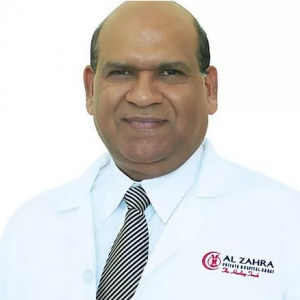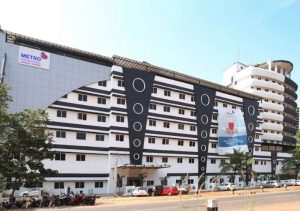Primary Aldosteronism
Aldosterone is the most effective mineralocorticoid secreted by the adrenals. It is responsible for the balancing of sodium and potassium in the blood. In the kidneys, aldosterone is responsible for the transfer of sodium, from the lumen of distal tubule to tubular cells, in exchange for potassium and hydrogen. This also takes place in the […] Read More
Top Doctors For Primary Aldosteronism Treatments
Top Hospitals For Primary Aldosteronism Treatments
Primary Aldosteronism
DIAGNOSIS OF PRIMARY ALDOSTERONISM
To diagnose primary aldosteronism (or primary hyperaldosteronism) the following analysis may be carried out- Measurement of aldosterone and renin in the blood: Renin is an enzyme secreted by the kidneys to help control blood pressure. If the level of renin in the blood is very low while that of aldosterone is high, it may be primary aldosteronism.
- Salt-loading test: This can be done with blood or urine, and can be carried out in a couple of ways. To carry out this test the patient eats a high-sodium diet for a few days. Alternatively, is a saline infusion for several hours after which the aldosterone levels are measured. In addition to the high-sodium diet, the patient may also be given fludrocortisone (a drug that mimics the action of aldosterone) before the test.
- Abdominal CT scan: This is requested to have a clear view of the adrenal gland, and check for a tumour or an enlargement. The presence of either suggests the gland is overactive.
- Adrenal vein blood test: Blood samples are drawn from both right and left adrenal veins and compared. If one side has elevated aldosterone, growth on that adrenal gland is suspected.
- Blood pressure measurement: High blood pressure is often the first indicator of primary hyperaldosteronism
TREATMENT
Conn’s syndrome treatment option depends on the underlying cause. Either ways, the essence is to restore the aldosterone levels to normal or to stop possible complications that may occur as a result of high aldosterone. For adrenal gland tumour treatment options are surgery or medications, and lifestyle changes The surgical removal of the adrenal gland along with the tumour is usually highly recommended. It may bring back the blood pressure, potassium and aldosterone levels to a normal level. The doctor will also follow up closely after surgery and progressively adjust or eliminate the medications for high blood pressure. Alternatively, aldosterone-blocking drugs (known as mineralocorticoid receptor antagonists) and lifestyle changes may be opted for instead of surgery. However, there will be a return of high blood pressure and low potassium once medications are discontinued. For an over-activity of both adrenal glands: a combination of medications and lifestyle modifications can effectively address this. POSSIBLE COMPLICATIONS CONN’S SYNDROME MAY LEAD TO The main complications that can arise from suffering from primary hyperaldosteronism are high blood pressure and low potassium levels. These complications also lead to several problems, such as- Heart attack, cardiac arrest, heart failure and other heart problems.
- Stroke, partial or full.
- Kidney disease or kidney failure.
- Weakness
- Asymmetrical heart rhythm
Symptoms
Onset of Conn’s syndrome symptoms are often unclear. The first clue of the presence of Conn’s syndrome is usually high blood pressure, which are very hard to control.
Sometimes, Conn’s syndrome causes low potassium levels.
Other likely Conn’s syndrome symptoms are
- Cramps may be experienced in the muscle.
- Weakness or tingling may be experienced in the muscle.
- Fatigue.
- Headache.
- Extreme thirst.
- Frequent need for urination.
- Numbness.
- Erratic temporary paralysis.
- Disturbances with vision.
Causes
The chief cause is the overproduction of aldosterone.
Other aldosteronism causes are –
- Benign growth in the adrenal gland.
- Over activity of both adrenal glands known as bilateral adrenal hyperplasia.
- Cancerous growth on the outside layer either or both of the adrenal glands.
- Genetics – hereditary of a condition known as glucocorticoid-remediable aldosteronism that causes high blood pressure in children and young adults.
FAQ
Who is likely to suffer from Conn’s syndrome?
Conn’s syndrome can be suffered by anyone. However, it’s more likely to be suffered by those who have:
- Low level of blood potassium.
- Developed high blood pressure before the age of 30.
- Hard to control high blood pressure, which requires three or more medications to manage.
- Adrenal mass.
When should I be scared of primary aldosteronism?
Be concerned about primary aldosteronism if you have
- Mild to severe high blood pressure, especially if it requires many medications for control.
- High blood pressure, and a family history of Conn’s syndrome.
- A family history of high blood pressure or stroke at the age 40 or younger.
- Growth on one or both of your adrenal glands with high blood pressure and
- High blood pressure and low level of potassium.
- Disruptive sleep apnea and high blood pressure.
In who is Conn’s syndrome or primary hyperaldosteronism common?
Primary hyperaldosteronism commonly occur in those between the ages of 30 and 50.
- What are lifestyle remedies for primary aldosteronism?
Living a healthy lifestyle can go a long way to help you with primary aldosteronism. A couple of such is
- Reduce sodium intake in your diet.
- Lose weight, if obese or if needed.
- Regular exercise.
- Quit alcohol consumption and smoking.








































































































